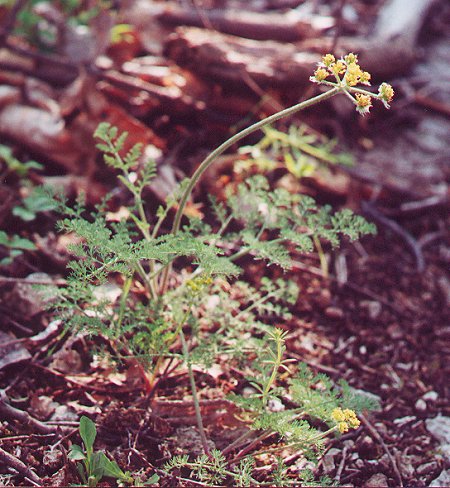Lomatium foeniculaceum (Nutt.) J.M. Coult. & Rose
Hairy Parsley

Native
CC = 9
CW = 5
MOC = 10
© DETenaglia
Lomatium foeniculaceum (Nutt.) J.M. Coult. & RoseHairy Parsley | |
 |
Native CC = 9 CW = 5 MOC = 10 |
© DETenaglia |
|
Family - Apiaceae Stems - Flowering stems to +/-25cm tall, branching or simple, single or multiple from the base, fragrant, carinate, villous to hirsute, herbaceous, erect, from a thick bulbous taproot. Leaves - Alternate, petiolate, 3-4 times pinnately divided. Petioles sheathing at base and often purplish at base. Entire leaf to -20cm long, 10-15cm broad, pilose. Primary divisions opposite, all other divisions alternate. Ultimate divisions linear to linear-oblanceolate, mucronate with a small whitish tip (use a lens to see), 3-4mm long, -1mm broad, with ciliate margins.
Inflorescence - Single terminal compound umbel per stem. Rays to 2cm long, densely pilose. Umbellets subtended by an involucre densely pilose bractlets. Bractlets linear-attenuate, to 4-5mm long, -1mm broad, +/-13 in number. Flowers +/-15 per umbellet. Pedicels to 2mm in flower, longer in fruit.
Flowers - Petals 5, yellow, glabrous, with an inflexed acuminate tip, 1.6-2mm long, .7mm broad. Stamens 5, spreading to erect. Filaments yellowish, +2mm long, glabrous. Anthers yellow, .6mm long. Styles 2, erect, 2.5mm long, curled, yellowish, glabrous, surrounded by an inflated nectary at base. Ovary inferior, green, glabrous, 1.5mm long, 2-locular. Sepals 5, whitish-green, acuminate, to .7mm long, glabrous. Fruits to 4mm long, 2.5mm broad, ellipsoid, pubescent, 2-seeded.
Flowering - April - May. Habitat - Prairies, glades, rocky open ground. Origin - Native to the U.S. Other info. - This little species is found in just a few counties in west-central Missouri. This species is easy to ID in the field. The fragrance and overall look of the plant (called gestalt by Doug Ladd), clearly place it in the Apiaceae. The big taproot is also a good indicator. Photographs taken at Blue Springs Park, Jackson County, MO., 4-22-01. |